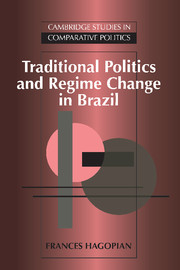Book contents
- Frontmatter
- Contents
- List of tables and figures
- Preface
- Glossary of abbreviations and Portuguese terms
- 1 Introduction: Traditional politics, new authoritarianism
- 2 Oligarchical power and traditional politics in Minas Gerais
- 3 The modern political economy of traditional politics
- 4 Bureaucratic authoritarianism and the state elite
- 5 Back to patronage: State clientelism in Minas Gerais
- 6 Authoritarian politics and traditional elites
- 7 The traditional political elite and the transition to democracy
- 8 Continuity in change: Brazilian authoritarianism and democratization in comparative perspective
- Appendix: The Minas elite
- References
- Index
1 - Introduction: Traditional politics, new authoritarianism
Published online by Cambridge University Press: 06 January 2010
- Frontmatter
- Contents
- List of tables and figures
- Preface
- Glossary of abbreviations and Portuguese terms
- 1 Introduction: Traditional politics, new authoritarianism
- 2 Oligarchical power and traditional politics in Minas Gerais
- 3 The modern political economy of traditional politics
- 4 Bureaucratic authoritarianism and the state elite
- 5 Back to patronage: State clientelism in Minas Gerais
- 6 Authoritarian politics and traditional elites
- 7 The traditional political elite and the transition to democracy
- 8 Continuity in change: Brazilian authoritarianism and democratization in comparative perspective
- Appendix: The Minas elite
- References
- Index
Summary
From 1964 to 1985 Brazil, Latin America's largest and most industrialized country, was governed by a military dictatorship, which on the surface was unlike its predecessors and was soon to become the model for other authoritarian regimes on the continent. Like other military governments before it, it deposed an elected president, repressed labor unions in order to carry out an austerity program, and imposed a moratorium on politics. Within a few brief years of coming to power, however, it shunned former allies and enlisted the support of new ones in the international arena to impose its own vision of radical economic and institutional change on the nation. If the military copied parts of its design for a new institutional configuration from the tapestry of earlier Brazilian history, its blueprint unambiguously looked to the future, not the past. In order to accomplish a sophisticated set of economic and security objectives, the new governors set out to demobilize and depoliticize society. In the name of national security, they did not hesitate to torture their enemies, real and imagined, who did or merely appeared to harbor “Communist” sympathies or oppose military rule. This military dictatorship was South America's first “bureaucratic authoritarian” regime.
The Brazilian “Revolution” of 1964, as the military called its coup d'etat, had two broad goals: to foster economic development and to recast politics. In the economic realm, Brazil's new military governors initially sought to control inflation and attract foreign investment. In the longer term, predominant factions within the military that envisaged Brazil as a future great power wished to harness the resources of the state to sustain a massive development project.
- Type
- Chapter
- Information
- Traditional Politics and Regime Change in Brazil , pp. 1 - 35Publisher: Cambridge University PressPrint publication year: 1996

